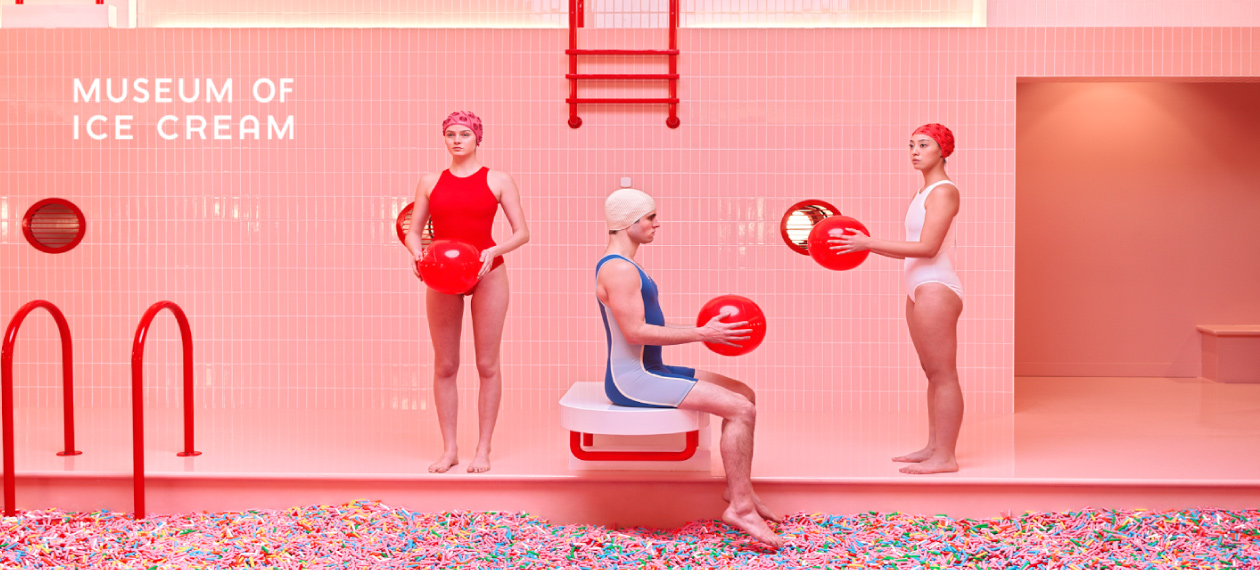When the founders of Museum of Ice Cream first set out to transform run-of-the-mill museum and retail experiences, their new endeavor “had nothing to do with ice cream.”
"I was living in New York City and I was bored,” Co-Founder, Manish Vora, explains. “I was bored with the traditional experiences, the traditional restaurants, the traditional nightclubs, the traditional passive entertainment, and we wanted to create a space of joy.”
Since the first pop-up location was unveiled in 2016, Museum of Ice Cream (MoIC) has welcomed millions of visitors and is one of the most popular immersive experiential concepts around. Today, there are permanent locations in five cities — New York, Austin, Chicago, Singapore, and Shanghai — with another slated to open in Miami early next year.
Speaking at RestaurantSpaces in Austin, Vora explored the principles underpinning MoIC, the role that social media plays in the concept’s success, as well as why the attraction continues to be so popular.
The Experience
In choosing the medium for the concept, Vora recognized ice cream as one of the most 'Instagrammable' foods. This insight drove him and his partner, Maryellis Bunn, to anchor their concept around this universally loved treat.
Their hunch undoubtedly had merit. Tickets sell out when new locations are opened to the public. The radical reinvention of the conventional ice cream parlor has lured not only celebrities like Ryan Reynolds, Katy Perry, Gwyneth Paltrow, and Kim Kardashian but also 3 million other members of the general public.
Installations within the spaces include highlights like the largest slide in New York, an animal cookie carousel, pools filled with millions of oversized, multicolored sprinkles, and various themed rooms — like the Hall of Freezers — which will be unveiled at the Miami location.
Originally aimed at adults in their 20s and 30s, MoIC has evolved into a family-friendly venue. While based on the idea of a museum, it discards traditional restrictive norms to encourage play and discovery. It can also be rented out for private events.
MoIC’s first permanent location was strategically situated across from the Whitney Museum of American Art. Predictably, Vora quipped, MoIC experienced longer queues.
Engagement in the Age of Social Media
Unsurprisingly, MoIC has an impressive social media presence. To date, the MoIC has garnered over one trillion social media impressions and Vora claims it’s the number one social media attraction in the world, per square foot.
“We did not have to spend one dollar marketing for the first million visitors we had. We were profitable on day one — we were sold out. Tickets were going for $4,000 in Los Angeles on the secondary market,” Vora recalled.
While Vora admits that social media is one of the biggest driving forces behind the concept’s success, conversely, it’s also one of the biggest hindrances to the experience.
“We’re averaging four to six hours a day on our cell phones. The cell phone is the biggest challenge we are facing in this country… and it is also the case for our experience,” Vora said. “Even though we get all of these people coming to our museum and posting [about it] for free, this is a problem.”
The widespread use of smartphones is a major consideration for anyone involved in space design today. For those in the restaurant business, this is particularly true. As digital increasingly becomes an integral part of a chain’s relationship with the guest, designers need to find ways of seamlessly weaving the technology into the customer journey, while not detracting from the in-store experience.
Vora illustrated his point by explaining what happens when they host “no phone days” at the museum — customer ratings “of the experience go up about 40 to 50 percent, consistently.”
Vora emphasized the importance of focusing on creating physical spaces that inspire a sense of exploration, discovery, and joy.
“The MoIC was not designed for social media. That was not the purpose of the museum,” he said. “Cell phones actually the biggest challenge we have to design in our spaces.”
Imagining Spaces that Inspire Joy
Vora closed out his talk by reiterating MoIC’s mission to "unite and inspire the world through imagination."
To keep the notion alive throughout the company, every team member has their own “ice cream name.” Vora revealed his own name, Flavor Flav, then called on audience members to close their eyes and come up with a unique ice cream name for themselves, on the spot.
After a spate of giggling and name-sharing from the crowd (“Corey Banana Chip,” “Berry-Mary-Go-Round”), Vora explained the principles that underpin the operation’s core ethos as they continue to create spaces that engage and entice the imaginations of their guests.
- Cone-ection (they embrace a good pun)
- Explore
- Activate senses
- Play
- Return to childhood
- Educate
"We’re going to make you explore and get you into spaces that are going to get you thinking and feeling nostalgia,” Vora said.
Posted by
Chain Restaurants Reimagined.
The Retreat to Reimagine Restaurant Development, Design + Technology.
April 12-14, 2026 | Miami, FL





-3.png)

-3.png)
-4.png)
-3.png)

Comments